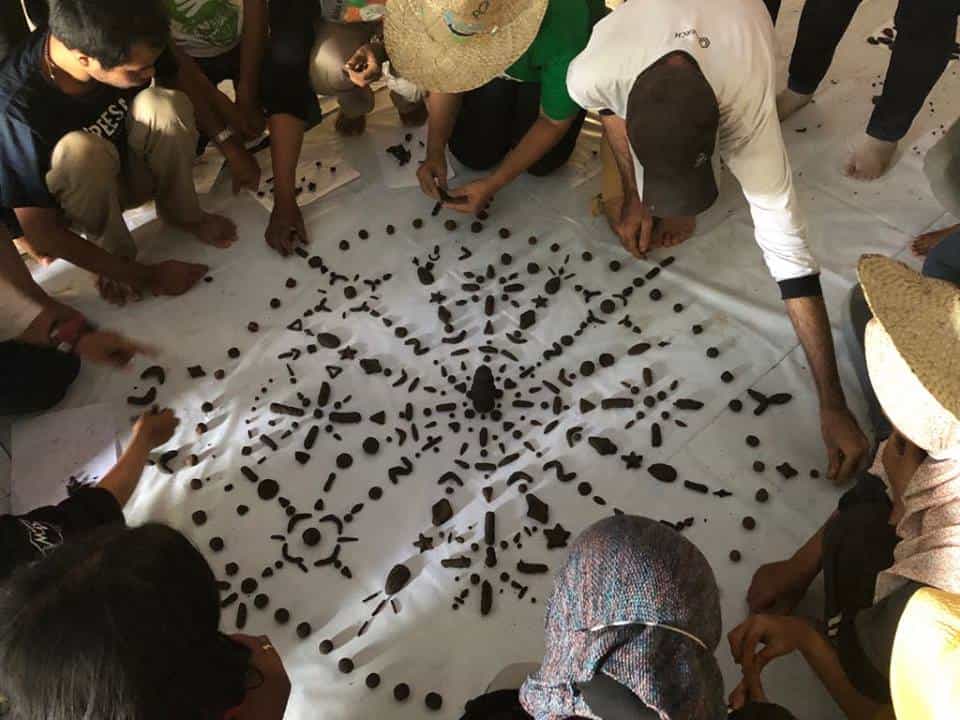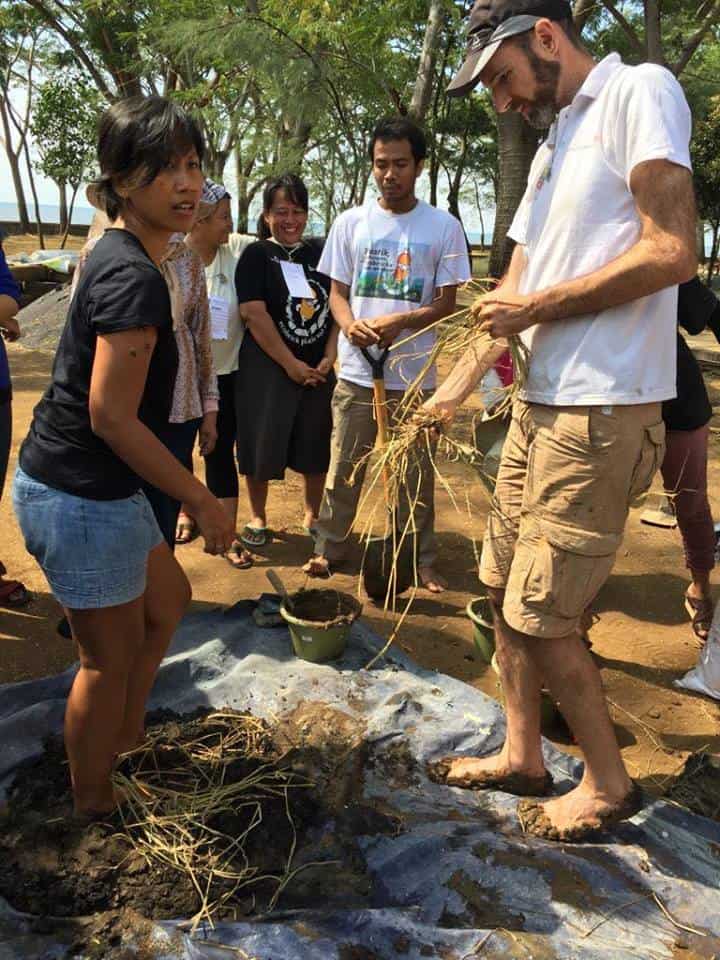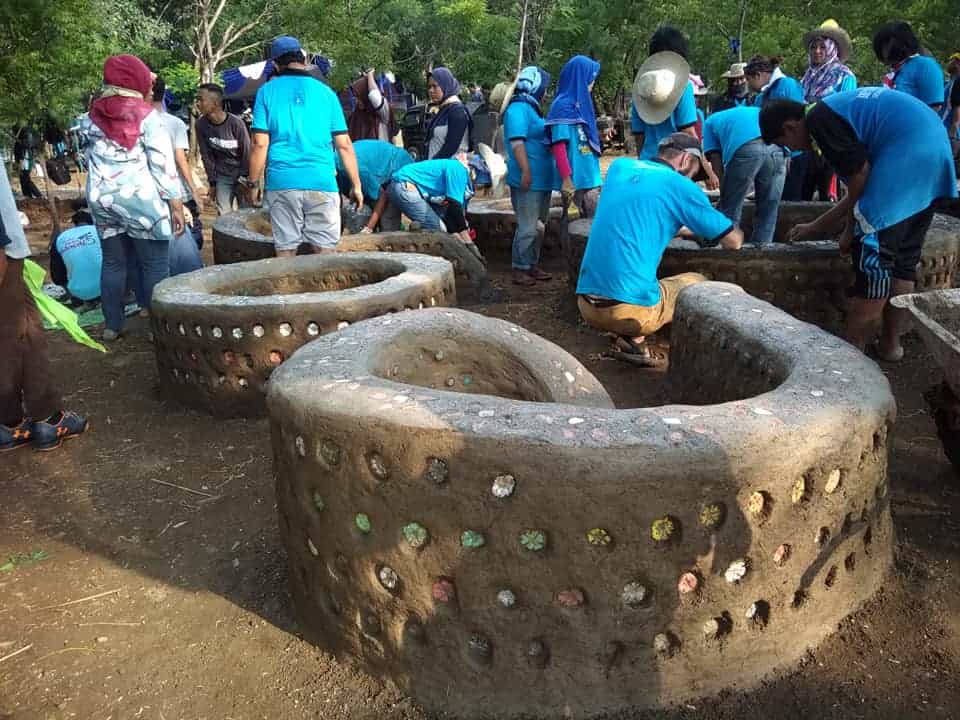We’re proud to announce the successful completion of the first GEA official Earth & Ecobrick Build in Probolinggo, East Java! The training had been four years in the works and a year in planning. The workshop introduced new brand new ecobrick concepts and techniques — in particular how to put ecobricks to use with earth construction methods.

With the spread of ecobricking now fully distributed in Indonesia and the availability of thousands of ecobricks a common occurrence in many cities, the time was right to introduce earth building — the next level in ecobrick application. Between April 24th and 28th, thirty three of our senior GEA trainers joined us from all over Indonesia, some traveling over 30 hours to make it for the five day event.
The workshop was hosted by PT.Paiton Energy who generously provided room on their campus for the participants to stay and assisted with logistics to see the creation of our Mandala Ecobrick park in a community space open to the public. The build was made possible by the local government of Probolinggo District who donated the space in a local public park– not to mention the contribution of hundreds of Probolinggo ecobrickers of 1200 ecobricks for the construction.
The training was led by GEA principals Russell Maier and Ani Himawati, and the implementation was spearheaded by Shanti Ramadhani (Sangar Hijau Indonesia) and her amazing on the ground team. It was Shanti’s dream to see the earth building happen and for ecobrick trainers assist. The training focused on the ecobrick and earth building techniques and principles developed by Russell, Mahitosh Eguia and Zellimere Strugar in the Philippines for building with ecobricks and bottles. However, in order to present earth building, it was essential to introduce several exciting new concepts that put the method into context.
Our new GEA flagship presentation is now released in Indonesian and English.
New GEA Presentation
The training also saw the unveiling of the new GEA presentation, Ecobrick & Earth Building. The first new GEA resource release in two years, the presentation makes use of the now iconic ecobrick illustrations of Filipino cartoonist El Tiburon Grande, and the work of Indonesia cartoonist Fabianus, to present the latest conceptual developments and scientific research by the GEA team. The presentation introduces the exciting new concepts of plastic sequestration, of mandalic collaboration theory, and regenerative philosophy. The presentation is specifically developed to assist our new Earth Builders in their community trainings as a short 45 minute session before volunteers jump into assisting with a build. The presentation, in Indonesian and English, is now available free for download from our new document repository.
Applied Mandalic Collaboration
A full half-day of the training was dedicated to mandalic collaboration theory (MTC). Developed and refined by GEA co-founder Russell Maier, this pedagogical technique has underlined the viral dissemination of ecobricks in South Earth Asia. The participants, each of whom brought earth from their home towns around Indonesia, used this earth to make personal, partner, team and group mandalas. On day four of the workshop the participants then had the opportunity to experience and implement mandalic theory. Two hundred volunteers joined, were divided into eight groups, and were led in the presentation by three trainers. Then, each team began their work on a separate element of the park.
In the spirit of mandalic collaboration theory, the design of the park drew from the ancestral traditions of Probolinggo. A month prior to the build, an advanced team had scouted out the nearby, 800 year old, Jabung temple, dating from the Majapahit era. The team gleaned symbols and geometry from the archetecture and temple relief to use in the design of the mandala park.
Construction
Over five days the park took shape! The first two days our core program participants learned from Russell and Ani how to lay the cement foundation, prepare cob and lay ecobricks. Together the 33 participants built the center circle of the mandala park. After having a chance to practice the Earth & Ecobrick Building presentation, the participants were then ready to lead their own building teams.
On day four, two hundred volunteers joined the build. The core participants then had the opportunity to experience and implement mandalic theory. Then, each team began their work on a separate element of the park. They were divided into eight groups, and were led in the presentation by three trainers. After the theoretical introduction, the teams moved to mixing cob and laying ecobricks in ‘cob’ mortar layer by layer. Finally, the outer skin of the bench was laid, with a strong cement top inlaid with patterns made out of broken tiles. As this park will receive considerable abuse from children at play and is fully exposed to the rain and sun, using cement to seal the top and sides was important.

Water damage can be see to our failed attempts at a fully organic outer skin.
Success & Failure
The workshop was not without setbacks. The trainers were eager to learn a fully organic finishing technique, so the four circle benches were finished using a cement skin and four were finished using a mix of cow dung and clay.
Unfortunately, a rain struck only several hours after the completion of the park and our organic mix did not have sufficient time to dry. The natural waterproofing properties of the cow dung did not have time to set. Consequently, the outer skin of the fully organic benches suffered water erosion damage. The four spiral bench, which were finished using our standard cement and clay outer skin remain in great shape.
It was in the end a good lesson for our team to learn how to mix and apply and organic render, while at the same time, experiencing the failure of the application. For outdoor park benches that will have extensive human use and with full exposure to the elements, alas, using cement in the finishing skin makes more sense.
The Paiton and Probolinggo park administrators are now overseeing the planting of the park and the sealing of damaged benches.
Maintenance & End of Life Agreement
As part of the hand-over process, a special terms of agreement (GEA Earth Building Terms of Transfer) was signed with the City of Probolinggo and Park management. Ecobrick constuctions are unique as they have the dual purpose of their intended physical usage, as well as securing ecobricks from degradation. It is thus essential to maintain earth ecobrick builds mindful of the plastic inside them. It is also integral that the destruction of the construction be intended and planned.
Destruction must be done in such a way as to not compromise the integrity of the ecobricks inside. In this way the ecobricks may be safely extricated and put to use in the next construction as per our cradle-to-cradle principles.

The Paiton and Probolinggo park administrators are now overseeing the planting of the park and the sealing of damaged benches.

Our new certified GEA Earth Builders can be found and enlisted for trainings on our Trainer Map @ www.ecobricks.org/map
Our New Certified Earth Builders
Congratulations to Anita, Amali, Reksi, Nina, Erni, Heni, Sofi, Ika, Lutfi, Umar, Hannie, Shanti, Nurhidayat, Tarto, Willa, Praja, Pinta, Wulan, Yuli, Galuh, Hayyi, Aisyah, Widi, Eko, Endang, Rere, Angel, Dessie, Indrawati, Corry, Nurul, Andrik, Suhairi. These folks are now all upgraded as Earth builders (plus their previous Trainer status). They are now listed as such on our GEA Trainer Map. Once they complete three community workshops their status will go up to Earth Builder Trainers.
More GEA Ecobrick & Earth Trainings to Come
Now that are first Ecobrick & Earth Training is complete… be on the look out for more! Our builders will now be leading their own builds throughout Indonesia. The GEA now is taking registrations for more E&E Training of Trainers. See our PDF Course Document in English or Indonesian.
Interested in an Ecobrick & Earth Build Training? Check out our course profile document.



















































